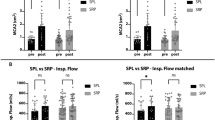Abstract
Purpose
This study aimed to compare open technique rhinoplasty with spreader graft and Let Down rhinoplasty using Nasal Symptom Obstruction Evaluation (NOSE), Sinonasal Outcome Test-22 (SNOT-22), and Visual Analog Scale (VAS).
Materials and methods
A total of 50 patients were included in the study. Patients with a hump greater than 4 mm and mild septal deviation participated in the study. The patients were divided into two groups. Group 1 consisted of 26 patients who underwent Let Down rhinoplasty, while Group 2 consisted of 24 patients who underwent open rhinoplasty with spreader graft. NOSE, SNOT-22, and VAS scales were completed by both groups preoperatively and postoperatively.
Results
There was no significant difference between the groups in terms of age and gender. Postoperative values of scales were significantly lower than preoperative values in Group 1 (p < 0.001). In Group 2, postoperative values were significantly lower than preoperative values (p < 0.001). There was no significant difference between the two groups according to NOSE, SNOT-22 and VAS scores.
Conclusion
According to the comparison of scale scores, both Let Down rhinoplasty and open technique rhinoplasty using spreader graft improved nasal functional results such as nasal obstruction.



Similar content being viewed by others
References
Cottle MH, Loring RM (1946) Corrective surgery of the external nasal pyramid and the nasal septum for restoration of normal physiology. Ill Med J 90:119–135
Huizing EH (1975) Push down of the external nasal pyramid by resection of wedges. Rhinology 13:185–190
Saban Y, Daniel RK, Polselli R, Trapasso M, Palhazi P (2018) Dorsal preservation: the push down technique reassessed. Aesth Surg J 38(2):117–131
Tuncel U, Aydogdu O (2019) The probable reasons for dorsal hump problems following let-down/push-down rhinoplasty and solution proposals. Plast Reconstr Surg 144(3):378e–385e
Lothrop OA (1914) An operation for correcting the aquiline nasal deformity; the use of new instrument; report of a case. Boston Med Surg J170:835–837
Apaydin F (2011) Nasal valve surgery. Facial Plast Surg 27(2):179–191
Sheen JH (1984) Spreader graft: a method of reconstructing the roof of the middle nasal vault following rhinoplasty. Plast Reconstr Surg 73:230–239
Adadan Güvenç I, Ecevit MC (2016) Subjective evaluation methods in chronic rhinitis and rhinosinusitis: quality of life questionnaires: review. Turkish J Rhinol 5(1):38–52
Stewart MG, Witsell DL, Smith TL et al (2004) Development and validation of the nasal obstruction symptom evaluation (NOSE) scale. Otolaryngol Head Neck Surg 130:157–163
Rudmik L, et al (2015) Patient-reported outcome measures for adult chronic rhinosinusitis: A systematic review and quality assessment. Journal of Allergy and Clinical Immunology. 136(6):1532–1540e2
Mladina R, Skitarelić N, Poje G, Šubarić M (2015) Clinical implications of nasal septal deformities. Balkan Med J 32(2):137–146
Gola R (2003) Functional and esthetic rhinoplasty. Aesth Plast Surg 27(5):390–396
Drumheller GW (1973) The push down operation and septal surgery. In: Daniel RK (ed) Aesthetic plastic surgery: rhinoplasty. Little Brown, Boston, pp 739–765
Kern EB (1978) Surgical approaches to abnormalities of the nasal valve. Rhinology 16(3):165–189
Daniel RK, Palhazi P (2018) The nasal ligaments and tip support in rhinoplasty: an anatomical study. Aesth Surg J 38:357–368
Durán-Vega HC, Regalado-Briz A (2019) Spreader graft easy and stable fixation. Plast Reconstr Surg Glob Open 7(3):e2168
Hassanpour SE, Heidari A, Moosavizadeh SM, Tarahomi MR, Goljanian A, Tavakoli S (2016) Comparison of aesthetic and functional outcomes of spreader graft and autospreader flap in rhinoplasty. World J Plast Surg 5(2):133–138
Mamanov M, Batioglu-Karaaltin A, Inci E, Erdur ZB (2017) Effect of spreader graft on nasal functions in septorhinoplasty surgery. J Craniofac Surg 28(7):e618–e621
Zeina AM, El Zeheiry AM, Bahaa El-Din AM (2020) True and average internal nasal valve area in septorhinoplasty: radiological and clinical outcomes. Ann Plast Surg 84(5):487–493
Saban Y, Braccini F, Polselli R (2006) Morphodynamic anatomy of rhinoplasty. Interest of conservative rhinoplasty. Rev Laryngol Otol Rhinol (Bord) 127(1–2):15–22
Saban Y (2018) Rhinoplasty: lessons from “errors”: from anatomy and experience to the concept of sequential primary rhinoplasty. HNO 66(1):15–25
Kosins AM, Daniel RK (2020) Decision making in preservation rhinoplasty: a 100 case series with one-year follow-up. Aesth Surg J. 40(1):34–48
Abdelwahab MA, Neves CA, Patel PN, Most SP (2020) Impact of dorsal preservation rhinoplasty versus dorsal hump resection on the internal nasal valve: a quantitative radiological study. Aesth Plast Surg 44(3):879–887
Strazdins E, Nie YF, Ramli R, Palesy T, Christensen JM et al (2018) Association between mental health status and patient satisfaction with the functional outcomes of rhinoplasty. JAMA Facial Plast Surg. 20(4):284–291
Funding
The authors declared that this article did not receive any financial support during the research and authorship process.
Author information
Authors and Affiliations
Corresponding author
Ethics declarations
Conflict of interest
The authors declared that there was no conflict of interest during the preparation and publication of this article.
Ethical approval
This study was carried out with the ethics committee approval of Toros University Scientific Research and Publication Ethics Committee (Decision No: 14).
Additional information
Publisher's Note
Springer Nature remains neutral with regard to jurisdictional claims in published maps and institutional affiliations.
Rights and permissions
About this article
Cite this article
Taş, B.M., Erden, B. Comparison of nasal functional outcomes of let down rhinoplasty and open technical rhinoplasty using spreader graft. Eur Arch Otorhinolaryngol 278, 371–377 (2021). https://doi.org/10.1007/s00405-020-06270-7
Received:
Accepted:
Published:
Issue Date:
DOI: https://doi.org/10.1007/s00405-020-06270-7




